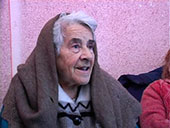
Pesia Kolodenker was born in Tulchyn in 1927. She is the sister of Lev and Aleksandr Kolodenker, as well as the husband of Nisen Kiselman. Her mother was a candy wrapper, before becoming a homemaker. She survived the war in the Tulchyn ghetto and Pechera concentration camp.
Other Interviews:
A Wealthy FamilyA Piece of Bread
Transport of Corpses
Bris
At the Yiddish School
Tulchyn, Ukraine
Yiddish-language education was an integral component of the Soviet shtetl in the 1920s and 1930s, and remains today a source of pride to those who benefited from it. The Soviet Union was the only country in the world with a state-sponsored system of Yiddish-language schools. In 1930, almost 95,000 children were studying in more than eight hundred Yiddish-language schools in Ukraine alone. Many of these were concentrated in the districts of Vinnytsya Province. In the twenty-one shtetls that comprised Tulchyn district, for instance, there were fourteen four-year Yiddish schools and eight seven-year schools in 1926. The movement to school Soviet citizens in their mother tongues was part of the policy of korenizatsiia, or nativization, which encouraged national minorities to use their own languages for local governance, cultural development, and education.6 Soviet ideologues rejected the Herderian notion that language is the primary receptacle of a nation’s cultural heritage, and instead believed that language was simply an empty vessel into which any ideology could be inserted. The Commissariat of Enlightenment had decreed that schools for national minorities be opened wherever there were a sufficient number of pupils to warrant the organization of such a school, and that these schools be afforded the same rights as schools of the majority language. The Commissariat of Nationality Affairs and the Commissariat of Enlightenment called for the formation of educational institutions in the languages of the national minorities as the most effective means of reaching these students. In addition to schools, the policy encouraged the formation of theaters, party cells, films, cultural clubs, and courts, all of which functioned in minority languages. Ukrainians were encouraged to attend Ukrainian-language schools; Germans were encouraged to attend German-language schools; and Jews were encouraged to attend Yiddish- language schools. The latter, though, were not to be confused with Jewish schools, as they deliberately avoided teaching children anything about the Jewish religion, preferring instead to promote a completely secular de-Judaicized vision of Jewish life. The Hebrew language, which had for centuries served as the predominant written language of Jewish erudition, was rejected as the language of the hated bourgeoisie and Zionist agitators. The bedrock of a traditional Jewish education—Bible, Talmud, and rabbinical knowledge—was excised from the school curriculum and instead a new secular curriculum was constructed ex nihilo. Many Jewish cultural traditions were thereby made inaccessible to graduates of Yiddish-language schools. As a result, many Jewish parents preferred to send their children to Russian-language schools. Schools made up for their academic shortcomings with material rewards. Students who showed up for classes were provided with food and hot soup. In this clip, Pesia Kolodenker of Tulchyn remembers how the school provided basic necessities for the poverty-stricken children. Source: Jeffrey Veidlinger, In the Shadow of the Shtetl: Small-Town Jewish Life in Soviet Ukraine (Indiana University Press, 2013)
